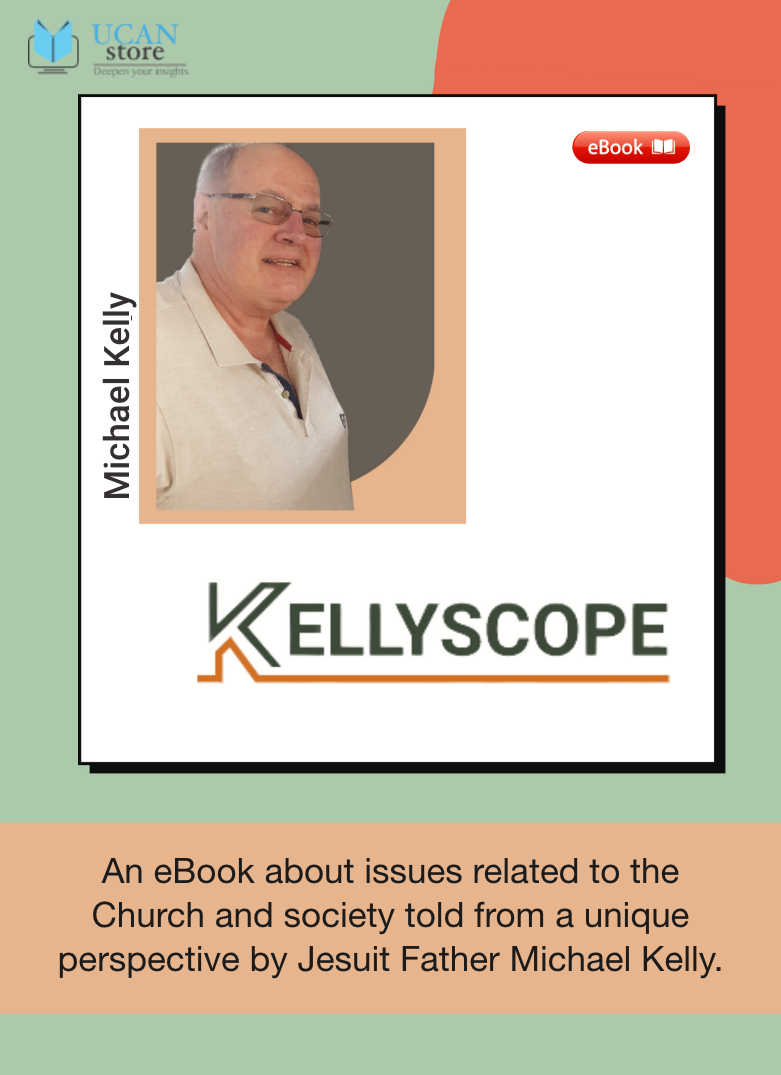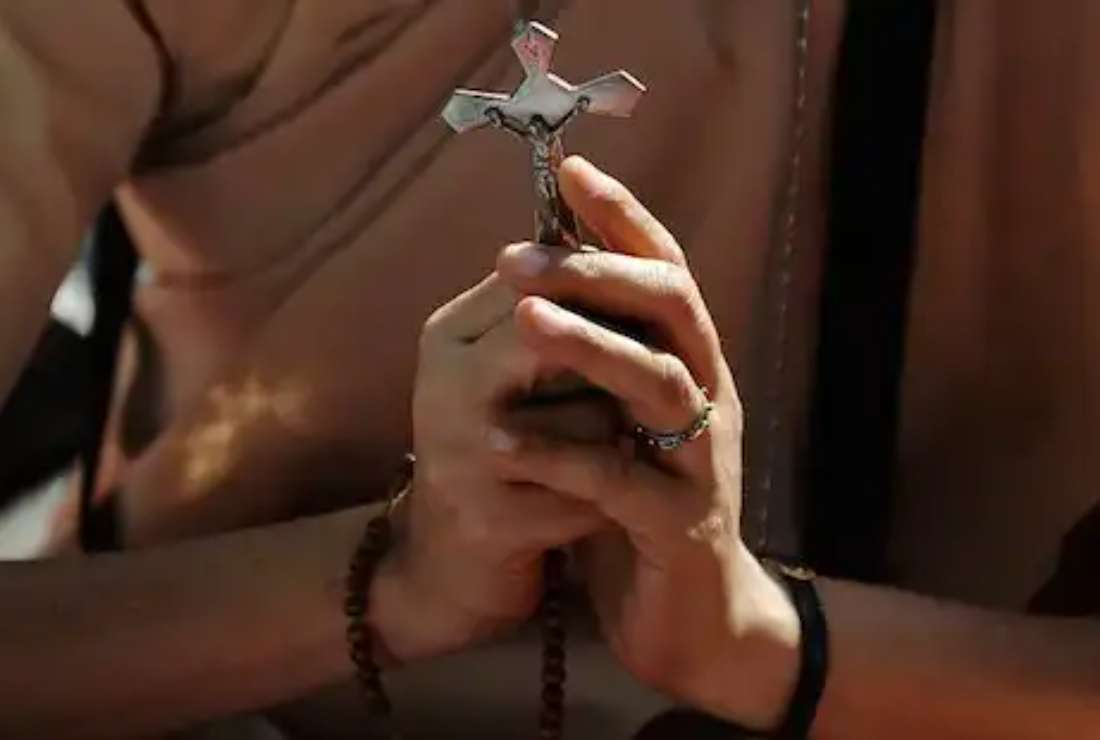

An Indian Catholic devotee holds a cross as she takes part in a protest in Mumbai on Feb. 9, 2015. (Photo: AFP/UCAN files)
Feb. 2, the feast of the Presentation of the Lord, has in recent years been devoted to a celebration of the Consecrated Life, the way in which religious dedicate themselves to Christ’s mission.
But no one dares ask whether this form of religious life has a future at all, or whether it will not mutate into something quite unpredictable.
Catholic religious life has had a rich and dynamic history — from the desert hermits of yore to the secular institutes today.
In its essence, it seeks to re-interpret the challenge of the Gospels (“an evangelical proclamation”) in the various historical contexts in which the Church finds itself.
Sadly Catholic religious life today finds itself in a state of “institutional captivity.”
Its prophetic dimension has been completely controlled by the institutional Church through canon law. As a result, most religious — be these priests or sisters — have become administrators or managers of their respective institutions.
Few of them are artists or visionaries, and even fewer still are prophets.
As a result, the institutional Church has become more and more identified with the values of the conservative right in society: superficial religiosity, property and obedience.
What does “institutional Church” mean?
Every institution is defined by at least four characteristics:
(a) stability (it is sure of itself and impervious to change);
(b) continuity (it wishes to expand and grow larger);
(c) security (it has built-in protective mechanisms to defend itself );
(d) uniformity/ homogeneity (it standardizes everything in the laws and rituals, so as to be recognizable everywhere.)
By contrast, “community” is defined by relationships that are more lateral than hierarchical (as exist in institutions).
Ideally, these community relationships may be described as strong, supportive and affectionate, and are marked by freedom and spontaneity, bringing about responsibility and creativity among its members.
As in Jesus’ time, a ‘community of disciples’ finds it easier to reflect evangelical values.
There are challenges to the unity of the community, of course. The chief of these being teamwork, diversity and conflict.
Sixty years ago, Vatican II attempted to break the institutional structure of the Church, and encourage a more communitarian model. In the process, there was a mass exodus of religious, men and women. However, the Council did not succeed completely.
What is needed is that Catholic religious life jettison the overly juridical template into which canon law has imprisoned religious life (“poverty,” “chastity,” “obedience”) and re-discover its evangelical roots (“radical poverty,” “detachment from family bonds.”)
Whether or not this can actually be done today, especially in Asian/African cultures, is the challenge. Why so? Unlike in the West, the family bonds of most Asian/African cultures are extensive and tight. Individual religious are expected to keep strong links with their family of origin, to solicit favors for it and for themselves.
Already in the 1930s, the Lutheran theologian Bonhoeffer grappled with the idea of a “religionless Christianity,” that is, a faith lived with less and less of a support structure (as under totalitarian Fascism in Nazi Germany).
Vinoba Bhave, the Gandhian, also spoke of the “demise of religion and the growth of spirituality.”
“Religious life” [understood here as the ‘consecrated life’] is the continuing quest for supernatural meaning through forms of dedication and public commitment.
However, in a sense, religious life is very much related to the kind of society one lives in.
In an agrarian age, the nature of society was feudal, and kinship was the universal bond.
Note, that even in technological societies today there are large numbers of migrants from other societies, who are in essence feudal/ tribal segments within the social body. Their values are different and frequently in conflict with the rest of society. Consider, for example, Muslims in Western Europe, or blacks and Latinos in the USA.
In the industrial age, it is the nation-state which assumes importance.
In a technological age (“a knowledge society”) it is not the nation as much as the market which is the dynamic factor in society.
Finally, in a cosmic age, it is the environment and a planetary consciousness that takes precedence.
Religious life in most traditions grew up in the agrarian age and expanded in the industrial age. It is being challenged today in the marketplace, and even more, by the Gaia hypothesis (the earth [Gk ‘ge’], and the universe as a living, conscious, evolving entity) which places our local religious traditions in the context of our survival in the cosmos.
So the problem is not so much one of ‘updating’ (aggiornamento) as of ‘mutating’ (as the caterpillar turns into the butterfly; or ice into steam; or the fetus into an infant…)
In other words, change is not just incremental and quantitative, but qualitative, of a different kind.
Modern living also brings with it other challenges: (a) the feminist revolution has made us re-value the role of women, sexuality, family life, etc. (b) the cultural revolution has revised our understanding of non-white cultures, and of non-Christian religions. (c) the digital revolution has changed the way our contemporaries communicate; (d) our environmental awareness has opened perspectives on life and nature we deliberately suppressed earlier.
All these phenomena ask us to define what it means to be “religious,” to be a “believer” today.
If religious communities are largely dysfunctional today — and I do believe they are — it is because all “life in common” — whether in families, neighborhoods, or nations — is under threat. (Remember Tolstoy? “Each unhappy family is unhappy in its own way.”)
Earlier, life in common was determined by patriarchal or hegemonistic modes. This was especially so in the Catholic Church. We have had many male founders of female religious orders, but have you ever heard of a female foundress of a male religious order?
Today, with democracy, each one wants to have his/her say, but does not wish to concede the same right to the “other.” Religious life more than often mimics the society in which it lives.
Perhaps building harmonious communities is the most significant ‘mission’ of religious life today! Could the Indian “ashram” serve as a template, I often wonder?
Today we see the future as discontinuous with the past. So it makes little sense “to go back to one’s roots” to “re-discover one’s original charism.”
Rather, one should emphasize discernment — what is God calling me to? How does one interpret change? How do we prepare for the future?
If Europe (and the West) is the antecedent of other cultures (in that what happens there today will take place here tomorrow), how shall we understand ‘spirituality’ and the tasks of ‘consecrated life’?
Certainly, spirituality can no longer be understood in terms of the opposition of soul and body, but more in terms of some kind of yoga (a union of spirit and body), of yin-yang (a blend of the male and female).
Put in other terms, it is towards the synthesis once proposed by Jung of anima/ animus (that is, the male/ female component in every human soul).
So celibacy is no longer an institutional requirement for mission but openness to mysticism, where sex becomes a metaphor for union.
The ecological awareness that we are all part of the universe, which is itself infused by the Spirit (see Romans 8.18-24) now, becomes the meaning of the Resurrection.
The tasks of the ‘consecrated life’ then are twofold, mysticism and prophecy, applied to the dharma-guru, the priest, or to the sadhvi, the religious woman of today.
The mystic stands for the discerning guide who interprets the “signs of the times,” and helps the disciple find “the truth of his own life,” and embrace it in love.
The prophet is a witness to God’s reign of justice, peace and love, a love which sacrifices itself to save the other
Wherever this community of disciples is found, with mystics and prophets among them, there the consecrated life of the future will thrive.
*The views expressed in this article are those of the author and do not necessarily reflect the official editorial position of UCA News.


